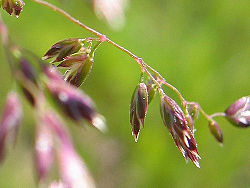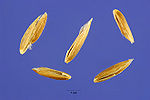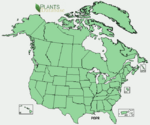Kentucky bluegrass
| Kentucky bluegrass |
|---|

|
| Scientific Classification |
|
| Subspecies |
|
| Close up of Kentucky Bluegrass |
Kentucky Bluegrass is one of the most widely distributed grasses in the United States. It gets its name from its flower heads, which are blue when the plant reaches its natural height. This is just one of the many characteristics that has made this grass such a hit. It is native to North America and has over 100 varieties that have been developed and made popular. Also known as Smooth Meadow-grass, it was given the species name Poa pratensis. God created this plant for a specific purpose and by learning about it, we are able to fulfill that purpose to the best of our abilities.
Anatomy
Kentucky Bluegrass is commonly known by the shape of its leaves. They are boat-shaped leaf tips that spread by rhizomes and tillers to form a dense sod. The new shoots for the plant are produced in the spring and late summer. The biggest influence on the growth of the grass is day length. Although important, temperature does not have as much of an affect on this organism. The day length causes a pattern of growth that goes from an erect position in summer, to a decumbent one in fall. It is also a major factor in the number of shoots developed by the plant. More shoots are produced during short days of spring than long days of summer. The plant itself grows from 18 to 24 inches tall. It is a rather dense grass, with smooth upright stems. The blades of the bluegrass remain green for 10 to 12 days during growing season, and typically, the shoot will have 3 to 4 green leaves at one time. The leaf blades are about 3 to 4 inches in summer and as the season changes, get shorter. This has to do greatly with the fact that this type of grass is a warm season grass, producing the best results mainly in summer. Some of the shoots can`also turn downward and develop rhizomes beneath the soil.[1] The flowers bloom between May and August, and are tiny, growing on small spikelets in clusters at the end of the stems. There are also tiny reddish fruits that will take the place of the flowers and provide seeds for many animals.[2]
Reproduction
This type of bluegrass reproduces through an asexual process called apomixis. This process produces offspring that are genetically identical to the mother plant. The seed is formed by apomictic reproduction, and as a result is very useful for maintaining traits from one generation to the next. There are many unique types of Kentucky Bluegrass with certain traits and characteristics that distinguish each. Apomixis is very beneficial for seed production and cultivar propagation, but poses a challenge for breeders. They have a very difficult time creating new varieties of the plant and putting all the important characteristics into one cultivar.[3] This reproductive process has been known as a vegetative propagation through seed. The plants have either facultative or obligate apomixes. Obligate means that the plant only produces through apomictic seed, while facultative produces by both apomixes and sexual reproduction. The most common type for Kentucky Bluegrass and typically all plants is facultative.[4]
Ecology
Kentucky Bluegrass is native to North America, and very prominent in the United States. Its exact native past has not been identified, but it is native in parts all across the U.S. Although it is grown all throughout the U.S., it is most abundant in the Northern half. Oregon and Washington are large producers of this grass because of their beneficial climates. Kentucky Bluegrass grows best on well-drained loams or clay loams rich in humus and soils with limestone materials. It is also crucial that it have large amounts of nitrogen during active growth stages. Meadows of dry to moist conditions and soils that are dark brown to black are a sure sign of bluegrass growth.[5] It is a very competitive plant that will crowd up whole sections so that it can grow. This type of bluegrass is perennial, meaning it is grown yearly.[6] Day length is also important to the ecology of this grass. It helps farmers and producers determine where to grow the bluegrass for best results and when. If planted during the summer in an area with longer days, the farmer is guaranteed to have an abundant turnout of his crop.
Cultivars
Kentucky Bluegrass is known for many of its cultivars. A cultivar is a cultivated plant that has been selected and given a specific name because of its appearance and characteristics.[7] Over 100 cultivars of Kentucky Bluegrass have been developed over the past 25 years. These different types all have certain criteria that must be met for proper growth. Certain varieties grow better in southern climates while others have moderate shade tolerance.[8] This has become one of the most popular grasses for harvesting because of its fine blades and ability to remain green year round in some areas. Ease of seeding and harvesting have made major developments throughout North America. Kentucky Bluegrass alone has been planted on acres of lawns and pastures throughout North America. It is used everywhere; from golf courses and sports fields, to your very own backyard.[9] The cultivars have been broken down into two major categories: common and improved. The common type are usually older varieties that have been used for decades. They generally have an upright growth habit and are highly susceptible to disease. The improved type are the newer releases that have been developed in the past few decades. They have a slower growth rate and improved tolerance to many common diseases.[10]
Gallery
References
- [11] NRCS. 5-21-09
- [12] Richard L. Duble. 5-21-09
- [13] Garden Guides. 5-23-09
- [14] Ohio State University. 5-23-09
- [15] Journal of Plant Registrations 3/09
- [16] Propagation of Kentucky Bluegrass by Josh Prust. 5-25-09
- [17] Wikipedia. 5-25-09
- [18] Seedland. 5-25-09
- [19] Grounds Maintenance. 5-25-09





